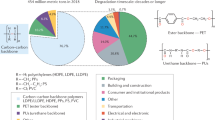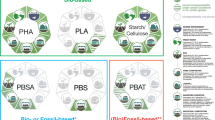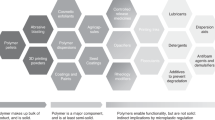Abstract
In our haste to ban or regulate unsustainable and environmentally damaging materials and chemicals, we may overlook dangers posed by their substitutes. In light of the scientific evidence regarding the fate, persistence and toxicity of microplastics in the marine environment, many countries have banned the sale of rinse-off cosmetics containing plastic microbeads to prevent their release to the environment. However, the wider lifetime environmental impacts of the potential substitutes have not been considered, and care must be taken so that the environmental costs of using them do not potentially outweigh the benefits resulting from the bans. In this study, we use life cycle assessment to compare the environmental performance of a wide range of potential alternatives. The study investigates the quantities of these materials required and the human health and environmental impacts of their manufacture, transport and inclusion in cosmetics. We highlight that the long-term environmental and human health effects of their disposal are unknown and are thus excluded from the life cycle assessment. In support of the responsible replacement of plastic microbeads in cosmetics, we identify several alternatives that will perform better, as well as substitutes that could pose additional risks and have undesirable effects.
This is a preview of subscription content, access via your institution
Access options
Access Nature and 54 other Nature Portfolio journals
Get Nature+, our best-value online-access subscription
$29.99 / 30 days
cancel any time
Subscribe to this journal
Receive 12 digital issues and online access to articles
$119.00 per year
only $9.92 per issue
Buy this article
- Purchase on Springer Link
- Instant access to full article PDF
Prices may be subject to local taxes which are calculated during checkout




Similar content being viewed by others
Data availability
The data that support the findings of this study are available from the corresponding author on request.
References
Zitko, V. & Hanlon, M. Another source of pollution by plastics: skin cleaners with plastic scrubbers. Mar. Pollut. Bull. 22, 41–42 (1991).
Gregory, M. R. Plastic ‘scrubbers’ in hand cleansers: a further (and minor) source for marine pollution identified. Mar. Pollut. Bull. 32, 867–871 (1996).
Fendall, L. S. & Sewell, M. A. Contributing to marine pollution by washing your face: microplastics in facial cleansers. Mar. Pollut. Bull. 58, 1225–1228 (2009).
Cole, M., Lindeque, P., Halsband, C. & Galloway, T. S. Microplastics as contaminants in the marine environment: a review. Mar. Pollut. Bull. 62, 2588–2597 (2011).
Beach, W. J. Skin cleaner. US patent US3645904A (1972).
Leslie, H. A. Review of Microplastics in Cosmetics (Institute for Environmental Studies, 2014).
Defra Implementation of the Environmental Protection (Microbeads) (England) Regulations 2017 Impact Assessment Report No. Defra2083 (HMSO, 2017).
Cole, M. et al. Microplastic ingestion by zooplankton. Environ. Sci. Technol. 47, 6646–6655 (2013).
Management of Marine Debris UNEP/CMS/Resolution 11.30 (United Nations Environment Programme, 2016).
The Environmental Protection (Microbeads) (England) Regulations 2017 UK SI no. 1312 2017 (HMSO, 2017).
Annex XV Restriction Report — Microplastics ECHA/PR/19/03 (European Chemicals Agency, 2019).
Waste Minimisation (Microbeads) Regulations 2017 Vol. 2017/291 (New Zealand Government, 2017).
Product Catalog Vol. LK_Katalog_AEF_V6_2017 (Lipoid Kosmetik AG, 2017).
KEMI Förslag till nationellt förbud mot mikrokorn av plast i kosmetiska produkter (Proposal for a National Ban on Plastic Microbeads in Cosmetic Products) Report No. 2/16 (Kemikalieinspektionen, 2016).
Bryce, E. The race to reinvent microbeads and avoid a plastic disaster. Wired (1 December 2018).
OSPAR Welcomes Cosmetics Industry Microplastics Pledge (OSPAR, 2015); https://www.ospar.org/news/ospar-marine-litter
Plastic in Cosmetics—Are We Polluting the Environment Through Our Personal Care? (United Nations Environment Programme, 2015).
Howard, G. From BPA to BPZ: A Toxic Soup? (CHEMTrust, 2018).
Diquat Dibromide (International Union of Pure and Applied Chemistry, 2009); http://sitem.herts.ac.uk/aeru/iupac/Reports/256.htm
Scheebaum, M. V. Biomonitoring of Herbicide Impact Using Aquatic Macrophytes: Laboratory and Field Studies for the Evaluation of Potential Toxicity on Aquatic Plants. PhD thesis, Albert-Ludwigs-Univ. (2006).
Woods, J. S., Veltman, K., Huijbregts, M. A. J., Verones, F. & Hertwich, E. G. Towards a meaningful assessment of marine ecological impacts in life cycle assessment (LCA). Environ. Int. 89–90, 48–61 (2016).
Sonnemann, G. V. et al. Medellin Declaration on Marine Litter in Life Cycle Assessment and Management (FSLCI, 2017); https://fslci.org/medellindeclaration
Downs, C. A. et al. Toxicopathological effects of the sunscreen UV filter, oxybenzone (benzophenone-3), on coral planulae and cultured primary cells and its environmental contamination in Hawaii and the U.S. Virgin Islands. Arch. Environ. Contam. Toxicol. 70, 265–288 (2016).
Moulite, M. Hawaii bans sunscreens that harm coral reefs. CNN (3 July 2018); https://edition.cnn.com/2018/07/03/health/hawaii-sunscreen-ban/index.html
Hou, J. et al. Toxicity and mechanisms of action of titanium dioxide nanoparticles in living organisms. J. Environ. Sci. 75, 40–53 (2019).
Heller, A., Jarvis, K. & Coffman, S. S. Association of type 2 diabetes with submicron titanium dioxide crystals in the pancreas. Chem. Res. Toxicol. 31, 506–509 (2018).
Kershaw, P. Exploring the Potential for Adopting Alternative Materials to Reduce Marine Plastic Litter (UNEP, 2018).
Regional Action Plan for Prevention and Management of Marine Litter in the North-East Atlantic (OSPAR, 2014).
Transforming Our World: The 2030 Agenda for Sustainable Development Report No. A/RES/70/1 (UN General Assembly, 2015).
Environmental Management — Life Cycle Assessment — Principles and FrameworkISO 14040:2006 (ISO, 2006).
Gouin, T. J. A. et al. Use of micro-plastic beads in cosmetic products in Europe and their estimated emissions to the North Sea environment. Int. J. Appl. Sci. (SOFW J.) 141, 40–46 (2015).
Herrmann, I. T. & Moltesen, A. Does it matter which life cycle assessment (LCA) tool you choose? A comparative assessment of SimaPro and GaBi. J. Clean. Prod. 86, 163–169 (2015).
Ponsioen, T. What’s New in SimaPro 8? (PRé Sustainability B.V., 2013); https://pre-sustainability.com/articles/publication-whats-new-in-simapro-8
Golsteijn, L. ReCiPe (PRé Sustainability B.V., 2012); https://www.pre-sustainability.com/recipe
Rumble, J. R. CRC Handbook of Chemistry and Physics 99th edn (CRC Press/Taylor & Francis, 2018).
Alibaba Sourcing Solutions Products by Category (Alibaba, accessed 17 September 2019); https://www.alibaba.com/Products?spm=a2700.8293689.201703.9.28f465aakiCEJ7
Murphy, F., Ewins, C., Carbonnier, F. & Quinn, B. Wastewater treatment works (WwTW) as a source of microplastics in the aquatic environment. Environ. Sci. Technol. 50, 5800–5808 (2016).
Sources, Fate and Effects of Plastics in the Marine Environment Report No. 90 (GESAMP, 2015).
Sherrington, C., Darrah, C., Hann, S., Cole, G. & Corbin, M. Study to Support the Development of Measures to Combat a Range of Marine Litter Sources (Eunomia, 2016).
Dris, R., Gasperi, J., Rocher, V., Saad, M. & Tassin, B. Microplastic contamination in an urban area: a case study in Greater Paris. Environ. Chem. https://doi.org/10.1071/EN14167 (2015).
Mato, Y. et al. Plastic resin pellets as a transport medium for toxic chemicals in the marine environment. Environ. Sci. Technol. 35, 318–324 (2001).
EAC Environmental Impact of Microplastics: Fourth Report of Session 2016–17 Report No. HC 179 (House of Commons, 2016).
Hulme, P., Davis, K. & Hickey, P. CSOs – the past, the present and the future. In CIWEM Urban Drainage Group Annual Conference 2014 (CIWEM, 2014); http://ftp2.ciwem.org/Document%20Tracker.xlsx
Sussarellu, R. et al. Oyster reproduction is affected by exposure to polystyrene microplastics. Proc. Natl Acad. Sci. USA 113, 2430–2435 (2016).
A Threat to Our Rivers: Plumbing Misconnections (Thames 21); https://www.thames21.org.uk/plumbing-misconnections
CBD Impacts of Marine Debris on Biodiversity: Current Status and Potential Solutions Technical Series No. 67 (Secretariat of the Convention on Biological Diversity and the Scientific and Technical Advisory Panel, GEF, 2012).
Andrady, A. L. Microplastics in the marine environment. Mar. Pollut. Bull. 62, 1596–1605 (2011).
Tanaka, K. et al. Accumulation of plastic-derived chemicals in tissues of seabirds ingesting marine plastics. Mar. Pollut. Bull. 69, 219–222 (2013).
Gregory, M. R. & Andrady, A. L. in Plastics and the Environment (ed. Andrady, A. L.) Ch. 10, 379–401 (John Wiley and Sons, 2003).
Seltenrich, N. New link in the food chain? Marine plastic pollution and seafood safety. Environ. Health Perspect. 123, A34–A41 (2015).
Acknowledgements
We thank J. Hunt, Marine Litter Policy Lead in the Marine Environment Strategy Team, Department for Environment, Food and Rural Affairs (Defra), UK, for identifying the policy need that the work presented here aimed to address.
Author information
Authors and Affiliations
Contributions
All authors were involved in the study conceptualization and design. C.F.H. led the writing of the original draft. C.F.H. and N.V. contributed to the review and editing. N.V. led the project supervision.
Corresponding author
Ethics declarations
Competing interests
The authors declare no competing interests.
Additional information
Peer review information Nature Sustainability thanks Olwenn Martin and the other, anonymous, reviewer(s) for their contribution to the peer review of this work.
Publisher’s note Springer Nature remains neutral with regard to jurisdictional claims in published maps and institutional affiliations.
Supplementary information
Supplementary Information
Supplementary Notes (Methods and Results), Figs. 1 and 2, Tables 1–6 and references.
Rights and permissions
About this article
Cite this article
Hunt, C.F., Lin, W.H. & Voulvoulis, N. Evaluating alternatives to plastic microbeads in cosmetics. Nat Sustain 4, 366–372 (2021). https://doi.org/10.1038/s41893-020-00651-w
Received:
Accepted:
Published:
Issue Date:
DOI: https://doi.org/10.1038/s41893-020-00651-w
This article is cited by
-
Fabrication of composite microbeads consisting of cellulose and covalent organic nanosheets via electrospray process
Cellulose (2024)
-
A novel simplified method for extraction of microplastic particles from face scrub and laundry wastewater
Scientific Reports (2023)
-
Spatiotemporal distribution and potential sources of atmospheric microplastic deposition in a semiarid urban environment of Northwest China
Environmental Science and Pollution Research (2023)
-
Latest advances in ionic liquids promoted synthesis and application of advanced biomass materials
Frontiers of Chemical Science and Engineering (2023)



